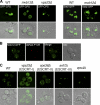New component of ESCRT-I regulates endosomal sorting complex assembly
- PMID: 17145965
- PMCID: PMC2064680
- DOI: 10.1083/jcb.200608053
New component of ESCRT-I regulates endosomal sorting complex assembly
Abstract
The endosomal sorting complex required for transport (ESCRT) complexes play a critical role in receptor down-regulation and retroviral budding. Although the crystal structures of two ESCRT complexes have been determined, the molecular mechanisms underlying the assembly and regulation of the ESCRT machinery are still poorly understood. We identify a new component of the ESCRT-I complex, multivesicular body sorting factor of 12 kD (Mvb12), and demonstrate that Mvb12 binds to the coiled-coil domain of the ESCRT-I subunit vacuolar protein sorting 23 (Vps23). We show that ESCRT-I adopts an oligomeric state in the cytosol, the formation of which requires the coiled-coil domain of Vps23, as well as Mvb12. Loss of Mvb12 results in the disassembly of the ESCRT-I oligomer and the formation of a stable complex of ESCRT-I and -II in the cytosol. We propose that Mvb12 stabilizes ESCRT-I in an oligomeric, inactive state in the cytosol to ensure that the ordered recruitment and assembly of ESCRT-I and -II is spatially and temporally restricted to the surface of the endosome after activation of the MVB sorting reaction.
Figures







Similar articles
-
Ordered assembly of the ESCRT-III complex on endosomes is required to sequester cargo during MVB formation.Dev Cell. 2008 Oct;15(4):578-89. doi: 10.1016/j.devcel.2008.08.013. Dev Cell. 2008. PMID: 18854142
-
Structure of the ESCRT-II endosomal trafficking complex.Nature. 2004 Sep 9;431(7005):221-5. doi: 10.1038/nature02914. Epub 2004 Aug 25. Nature. 2004. PMID: 15329733
-
Vps27 recruits ESCRT machinery to endosomes during MVB sorting.J Cell Biol. 2003 Aug 4;162(3):413-23. doi: 10.1083/jcb.200302136. J Cell Biol. 2003. PMID: 12900393 Free PMC article.
-
Endosomal and non-endosomal functions of ESCRT proteins.Trends Cell Biol. 2006 Jun;16(6):317-26. doi: 10.1016/j.tcb.2006.04.004. Epub 2006 May 22. Trends Cell Biol. 2006. PMID: 16716591 Review.
-
Structure and function of ESCRT-III.Biochem Soc Trans. 2009 Feb;37(Pt 1):156-60. doi: 10.1042/BST0370156. Biochem Soc Trans. 2009. PMID: 19143622 Review.
Cited by
-
UMA and MABP domains throw light on receptor endocytosis and selection of endosomal cargoes.Bioinformatics. 2010 Jun 15;26(12):1477-80. doi: 10.1093/bioinformatics/btq235. Epub 2010 May 6. Bioinformatics. 2010. PMID: 20448139 Free PMC article.
-
Regulation of Tsg101 expression by the steadiness box: a role of Tsg101-associated ligase.Mol Biol Cell. 2008 Feb;19(2):754-63. doi: 10.1091/mbc.e07-09-0957. Epub 2007 Dec 12. Mol Biol Cell. 2008. PMID: 18077552 Free PMC article.
-
ESCRT ubiquitin-binding domains function cooperatively during MVB cargo sorting.J Cell Biol. 2009 Apr 20;185(2):213-24. doi: 10.1083/jcb.200811130. J Cell Biol. 2009. PMID: 19380877 Free PMC article.
-
The ESCRT machinery in endosomal sorting of ubiquitylated membrane proteins.Nature. 2009 Mar 26;458(7237):445-52. doi: 10.1038/nature07961. Nature. 2009. PMID: 19325624 Review.
-
The Role of Exosome and the ESCRT Pathway on Enveloped Virus Infection.Int J Mol Sci. 2021 Aug 22;22(16):9060. doi: 10.3390/ijms22169060. Int J Mol Sci. 2021. PMID: 34445766 Free PMC article. Review.
References
-
- Babst, M., G. Odorizzi, E.J. Estepa, and S.D. Emr. 2000. Mammalian tumor susceptibility gene 101 (TSG101) and the yeast homologue, Vps23p, both function in late endosomal trafficking. Traffic. 1:248–258. - PubMed
-
- Babst, M., D.J. Katzmann, E.J. Estepa-Sabal, T. Meerloo, and S.D. Emr. 2002. a. Escrt-III: an endosome-associated heterooligomeric protein complex required for mvb sorting. Dev. Cell. 3:271–282. - PubMed
-
- Babst, M., D.J. Katzmann, W.B. Snyder, B. Wendland, and S.D. Emr. 2002. b. Endosome-associated complex, ESCRT-II, recruits transport machinery for protein sorting at the multivesicular body. Dev. Cell. 3:283–289. - PubMed
Publication types
MeSH terms
Substances
LinkOut - more resources
Full Text Sources
Molecular Biology Databases

